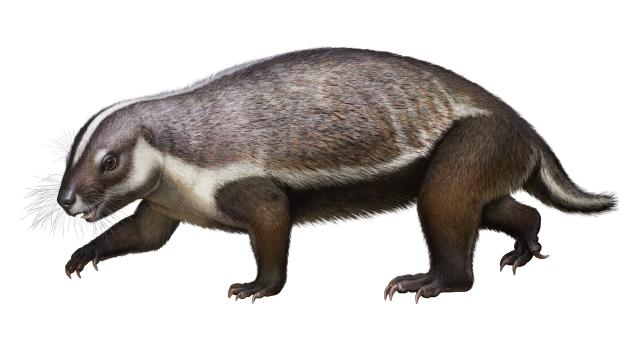An incredible skeleton unearthed in Madagascar over 20 years ago has finally been studied in detail. The well-preserved bones reveal a “crazy beast” that was unlike any mammal living today.
The creature belongs to a new genus and species called Adalatherium hui. Its genus name translates to “crazy beast,” while its species name honours researcher Yaoming Hu who helped analyse the fossil but passed away in 2008. The specimen represents a poorly understood group of mammals called Gondwanatherians, but this individual had lots of seemingly unique features. The researchers think that the uniqueness comes from the species evolving in isolation on the island of Madagascar for at least 20 million years.
“This is an absolutely exceptional specimen,” study author Simone Hoffmann, assistant professor in the department of anatomy at the New York Institute of Technology, told Gizmodo in an email. “It is really a once-in-a-life time find. Specimens of this quality and preservation are extremely rare, in particular from the southern hemisphere.”
Scientists uncovered this specimen back in 1999 as part of fieldwork in Madagascar that turned up lots of other wacky-looking fossils, like a dinosaur with its teeth pointing outward. Hoffmann joined the team in 2013 to study the skeleton for her Ph.D thesis. The scientists announced their findings today with a paper published in Nature and plan to release an even more detailed report soon.
A. hui was a member of the little-known Gondwanatherian family of mammals but was much larger than other known Gondwanatherians, at around the size of a Virginia opossum. While reconstructions made it look somewhat like a badger with a whiskered snout, many of its features were unlike any known in other creatures. It had a hole-filled skull, which probably made room for lots of nerves and blood vessels leading to its nose. Its teeth were shaped differently than those of any other mammal, and it had more vertebrae than its contemporaries. Its stance was equally strange: It held its front limbs straight down like any other modern mammal, but its rear limbs splayed outwards like an alligator’s.
This isn’t the only known Cretaceous period mammal, but it’s the oldest found in the southern hemisphere, which has a dearth of prehistoric mammal specimens overall. Jin Meng, the paper’s reviewer and curator in charge of Fossil Mammals at the American Museum of Natural History, told Gizmodo that this is because fewer paleontologists have carried out expeditions in the southern hemisphere, there are fewer fossil-preserving landscapes in the south, and perhaps the fauna that existed during the time was less diverse in the southern hemisphere than the northern hemisphere.
How did A. hui get so weird? It’s evolution on an island likely had something to do with it. Madagascar separated from other landmasses around 88 million years ago, so any animals that were on the island evolved in isolation. The controversial “island rule” posits that isolation on islands causes smaller species to grow larger (from a lack of predators), larger species to grow smaller (from a lack of resources), and all species to develop weird features, Hoffmann explained. There are plenty such examples on islands around the world today, but few examples for ancient mammals.
A. hui seems to be a prime candidate for an ancient mammal showing off island rule-like traits, given its size and odd features. However, this is just one specimen, and it will take more analysis of ancient island fossils to see whether the island rule was influencing evolution on ancient Madagascar. Additionally, this creature’s lineage died with the dinosaurs, so the mammals on Madagascar today evolved from some other event that brought them to the island—perhaps they hitched rides on rafts of floating vegetation, study lead author David Krause from the Denver Museum of Nature and Science said during a press call.
Now that scientists have unveiled this creature to the public, it’s time to learn more about it.
